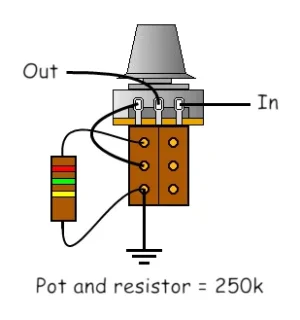Rex_Rocker
Well-known member
So I ordered a couple push/pull (or rather, push/push, really) 500K pots. One, I used in the bridge position with a JB. In one position, it sees a 300K-ish load. In the other, it sees 500K. It's cool to have both sounds available, subtle as the difference may be.
However, I've got another spare push/push pot, and no idea what to do with it. Ideally, I'd like to be able to coil split the neck pickup, but the 490R I have in there right now is a braided wire, rather than 4 conductor... so there it goes.
I really don't want something that means having to completely rewire the whole guitar. I'd like to keep it simple. I was thinking about splitting the bridge pickup there, although the "pot" part would be controlling the neck volume. That is doable, right?
But what other fun ideas do you guys have that I could try out? I suppose the rules of the game is I want to have two volumes, one for the neck, one for the bridge. I want to keep the bridge volume with the function that it has right now as is. It's just I've got an extra DPDT switch to play with. I don't want to add tone controls either. Not a fan. I want something that I'll actually use even if it's just from time to time.
Thank you!
However, I've got another spare push/push pot, and no idea what to do with it. Ideally, I'd like to be able to coil split the neck pickup, but the 490R I have in there right now is a braided wire, rather than 4 conductor... so there it goes.
I really don't want something that means having to completely rewire the whole guitar. I'd like to keep it simple. I was thinking about splitting the bridge pickup there, although the "pot" part would be controlling the neck volume. That is doable, right?
But what other fun ideas do you guys have that I could try out? I suppose the rules of the game is I want to have two volumes, one for the neck, one for the bridge. I want to keep the bridge volume with the function that it has right now as is. It's just I've got an extra DPDT switch to play with. I don't want to add tone controls either. Not a fan. I want something that I'll actually use even if it's just from time to time.
Thank you!

